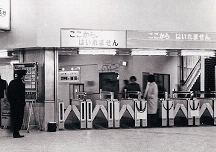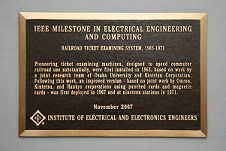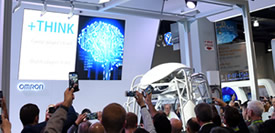Automated Railway Ticket Gate System Named IEEE Milestone - Recognition Goes to History of Joint Achievements by Osaka University, Kintetsu, OMRON and Hankyu from Development to Deployment -
FOR IMMEDIATE RELEASENovember 27, 2007
 The world's first automated ticket gate system was installed in Hankyu Railway's Kita-Senri station in March 1967. |
 IEEE Milestone Plaque |
Osaka University, Kintetsu Corporation ( 'Kintetsu'), OMRON Corporation ( 'OMRON') and Hankyu Corporation ( 'Hankyu') today received the prestigious Milestone designation1 from the Institute of Electrical and Electronics Engineers (IEEE2) in recognition of the parts they played in the development and deployment of automated railway ticket gates.
IEEE is the world's leading professional association in the fields of electrical, electronics and computer engineering, and telecommunications. The IEEE Milestone designation recognizes the innovations achieved by the four parties over the period from 1965 to 1971. These achievements range from research on the logic architecture for high-speed validation of commuter passes to the deployment of automated ticket gates capable of accepting both magnetic tickets and commuter passes.
Nearly 40 years ago, Osaka University and Kintetsu launched a research project aimed at automating commuter ticket inspection and validation. The project reflected an earnest desire to relieve congestion at ticket gates in train stations during rush hour, which was a major social issue in Japan at the time. The first outcome of this joint research was a calculation method for verifying the prescribed route and section of each passenger's commuter pass. This method was further refined so that it could be implemented on routes where fares differ depending on the boarding and destination stations. The joint efforts of Kintetsu and OMRON then led to the development of a new mechanism called the 'Normally Open Gate System', which was unique to Japan. This system can speedily check and validate a large number of commuter passes in succession while keeping the gate open. The development drove progress in the practical application of automated ticket gates. R&D work on automated ticket gates was then taken over by OMRON and Hankyu, finally leading to the deployment of the world's first automated ticket gate system at Hankyu Railway's Kita-Senri station in March 1967. The system consisted of machines that accepted punch-card commuter passes and machines that handled regular tickets with magnetically recorded (barcode) information.
Later, the Congress of Japan Railway Cybernetics (CJRC) established magnetic recording as the standard data recording technology for ticket gate machines. In response, Kintetsu and OMRON jointly developed an automated gate machine that met the CJRC's standards with its ability to read magnetic commuter pass cards in 1971. In April of the same year, automated ticket gate machines were installed and put into operation at Kintetsu Railway's 19 stations including Osaka-Abenobashi station. This large-scale, simultaneous deployment prompted many other railway companies to introduce automated ticket gates in their own systems. In 1972, Hankyu replaced their gates at Kita-Senri station with new machines designed for use with both magnetic card type commuter passes and tickets. By 1975, virtually all private railway lines and subways in the Kansai area (Osaka, Kobe and Kyoto) had implemented automated ticket gate systems.
In the 1970s, deployment of automated ticket gates accelerated, centering on the Kansai region of Japan. In the Kanto region (Tokyo and neighboring prefectures), deployment was slower due to the complexity of the railway network. The challenge was to create common-use tickets for connecting the lines of multiple transit operators. With technological breakthroughs that enabled tremendous increases in data storage capacity for magnetic tickets, the deployment of gate systems advanced quickly in the Kanto region after 1990.
In 1991, East Japan Railway Company (JR East) launched its 'IO-Card', a stored value card that could be directly inserted into ticket gates. Hankyu introduced a similar system on all of its lines in 1992. Such developments greatly improved passenger convenience.
In 1996, the 'surutto KANSAI' prepaid rail pass service was launched by five railway companies in Kansai. It allowed the use of a single common card on many different lines operated by multiple railroads, subways and buses in the Kansai region-the first of its kind in Japan. During the course of these developments, technological breakthroughs produced by OMRON and other manufacturers gave rise to further improvements in passenger convenience through the introduction of gates that could simultaneously process a ticket and card or two cards together. The debut of automated ticket gates for Shinkansen (bullet train) tickets also expanded usage of these machines.
Recently, the deployment of automated ticket gates compatible with contactless IC cards has spread throughout Japan. At the same time, more and more rail, subway, bus and other service companies allow common use of a single IC card. New applications of automated ticket gates that go beyond inspecting train passes/tickets are also being promoted, such as OMRON's new 'Anshin Goopas' (Goopas Child Safeguard). This service is designed to send an email notification to a parent's mobile phone when a child commuting to school passes through a ticket gate using a specific IC card. Through these and other services, the recipients of this IEEE Milestone designation are determined to continue contributing to people's safety, security and comfort.
Reference
-
IEEE Milestones Citation
The following is the citation on the IEEE Milestone plaque:- Railroad Ticket Examining System, 1965-1971
-
Pioneering ticket examining machines, designed to speed commuter railroad use substantially, were first installed in 1965, based on work by a joint research team of Osaka University and Kintetsu Corporation. Following this work, an improved version - based on joint work by OMRON, Kintetsu, and Hankyu Corporations using punched cards and magnetic cards - was first deployed in 1967, and at nineteen stations in 1971 .
-
History from development to deployment of automated ticket gate systems
October 1962 Kintetsu set up an in-house preparatory project for automating ticket-checking operations, and began work on the development of automated ticket gates. November 1963 Development work of automated ticket gates was transferred from Kintetsu to Kinki Sharyo Co. Ltd. Research Institute as an independent research project. February 1964 Kintetsu set up Cybernetics Study Workshop for the development of automated ticket gates. August 1964 Osaka University and Kintetsu developed a calculation method for validating the applicable routes and sections of tickets. September 1964 Joint development project by OMRON and Kintetsu was launched. February 1965 to April 1966 OMRON and Kintetsu produced prototype automated ticket gate machines (No. 1 to 4) and conducted field tests. March 1967 OMRON and Hankyu developed an automated ticket gate machine for Hankyu Railway based on the above prototype. Automated ticket gate machines for use with punched cards were deployed at Kita-Senri station (later replaced with automated ticket gate machines accepting magnetic cards). April 1971 OMRON and Kintetsu developed an automated ticket gate accepting magnetic cards for Kintetsu Railway. These gates were installed at 19 stations including the Osaka-Abenobashi station.
- 1 IEEE Milestones in Electrical Engineering and Computing
- IEEE Milestones in Electrical Engineering and Computing is a program established by IEEE in 1983 to honor significant achievements in the history of electrical, electronics and computer engineering that have made outstanding contributions to society. Currently, there are more than 70 Milestones around the world, including Volta's Electrical Battery Invention and the Fleming Valve. In Japan, six Milestones have been designated to date, namely the Yagi-Uda Directive Short Wave Antenna (1995), Mount Fuji Radar System (2000), Tokaido Shinkansen (Bullet Train) (2000), Seiko's Electronic Quartz Wristwatch (2004), Sharp's Pioneering Work on Electronic Calculators (2005), and Victor's Development of VHS, the World Standard of Home VTR (2006). The Automated Railroad Ticket Gate System is the seventh Milestone designated in Japan.
- 2 IEEE (The Institute of Electrical and Electronics Engineers, Inc.)
- The Institute of Electrical and Electronics Engineers, Inc. or IEEE (pronounced Eye-triple-E) is the world's largest non-profit organization of electrical and electronics professionals and is headquartered in the United States. Its membership consists of over 370,000 electrical and electronics engineers, scientists and professionals from over 150 countries around the world. IEEE is a leading authority on diverse areas ranging from computers, electronics and telecommunications to electric power, aerospace systems and biomedical engineering. Currently, IEEE consists of 39 societies, organized around specialized technical fields, and is engaged in holding international conferences, publication of journals, and development of standards. In Japan, there are nine local sections including Tokyo and Kansai Sections, with approximately 13,000 members.
- For media related enquiries, please contact:
- James Seddon (james_seddon@omron.co.jp)
Sarah Hall (sarah_hall@omron.co.jp)
at OMRON Corporate Communications Department
Telephone: +81 3 3436 7202






